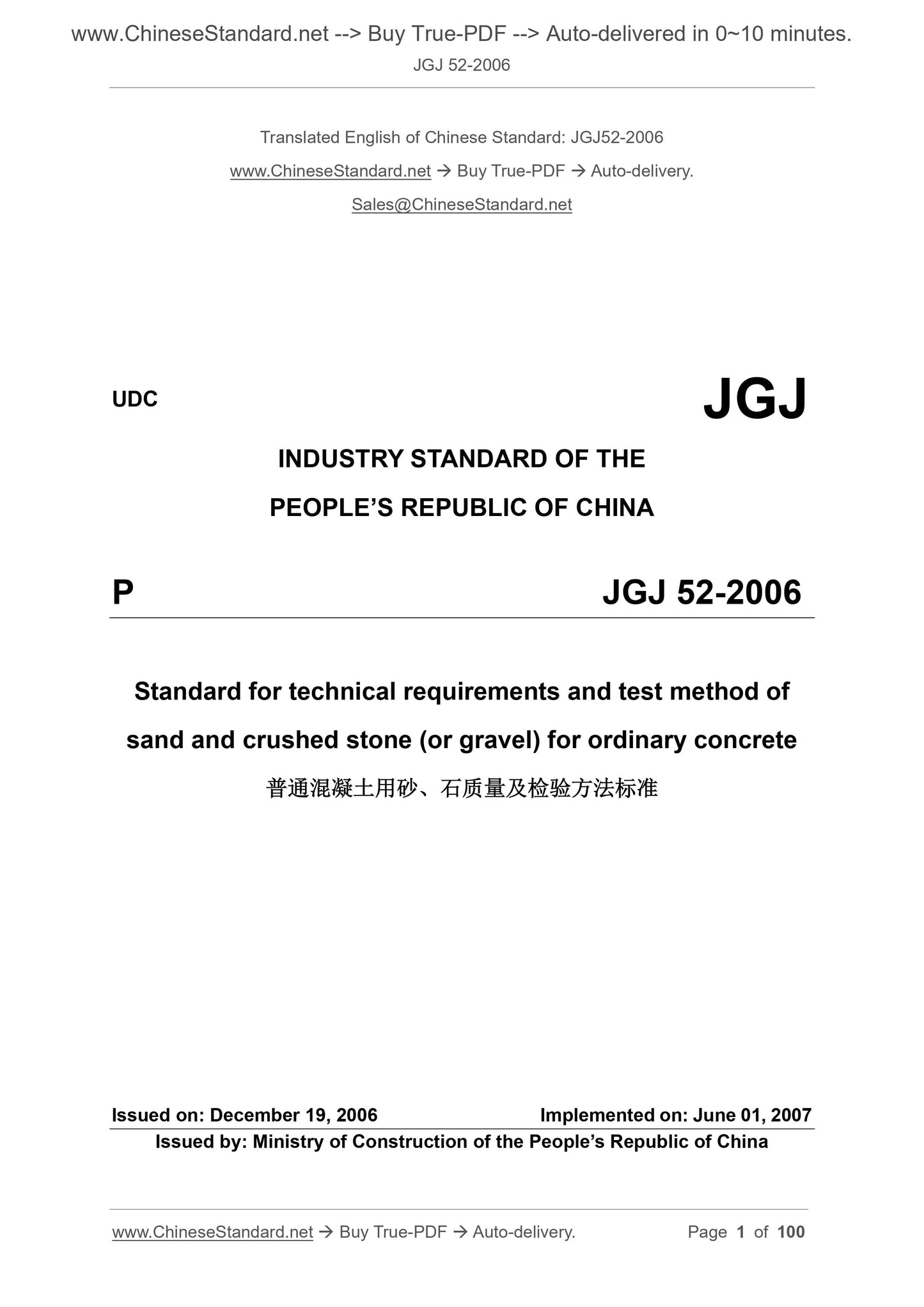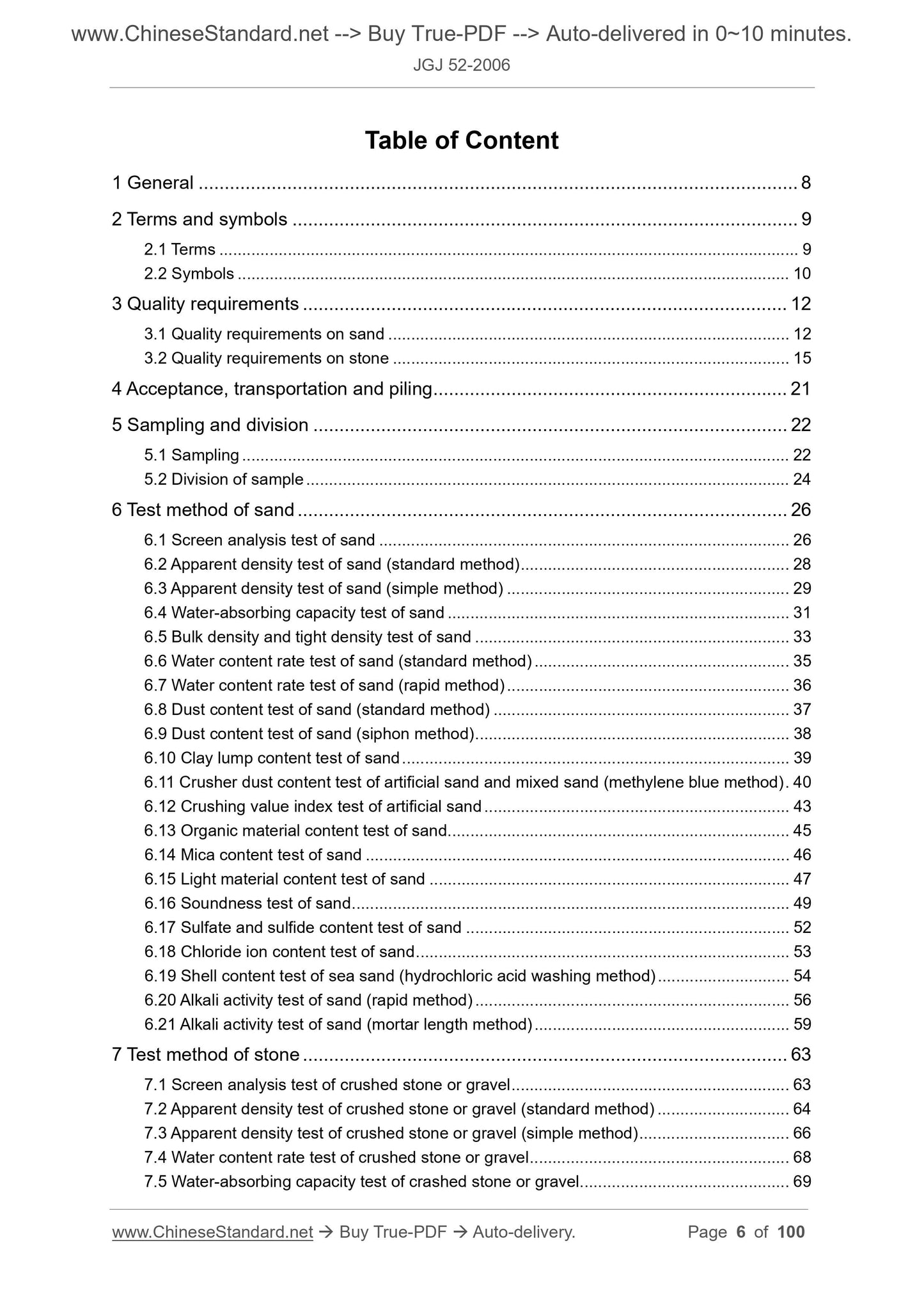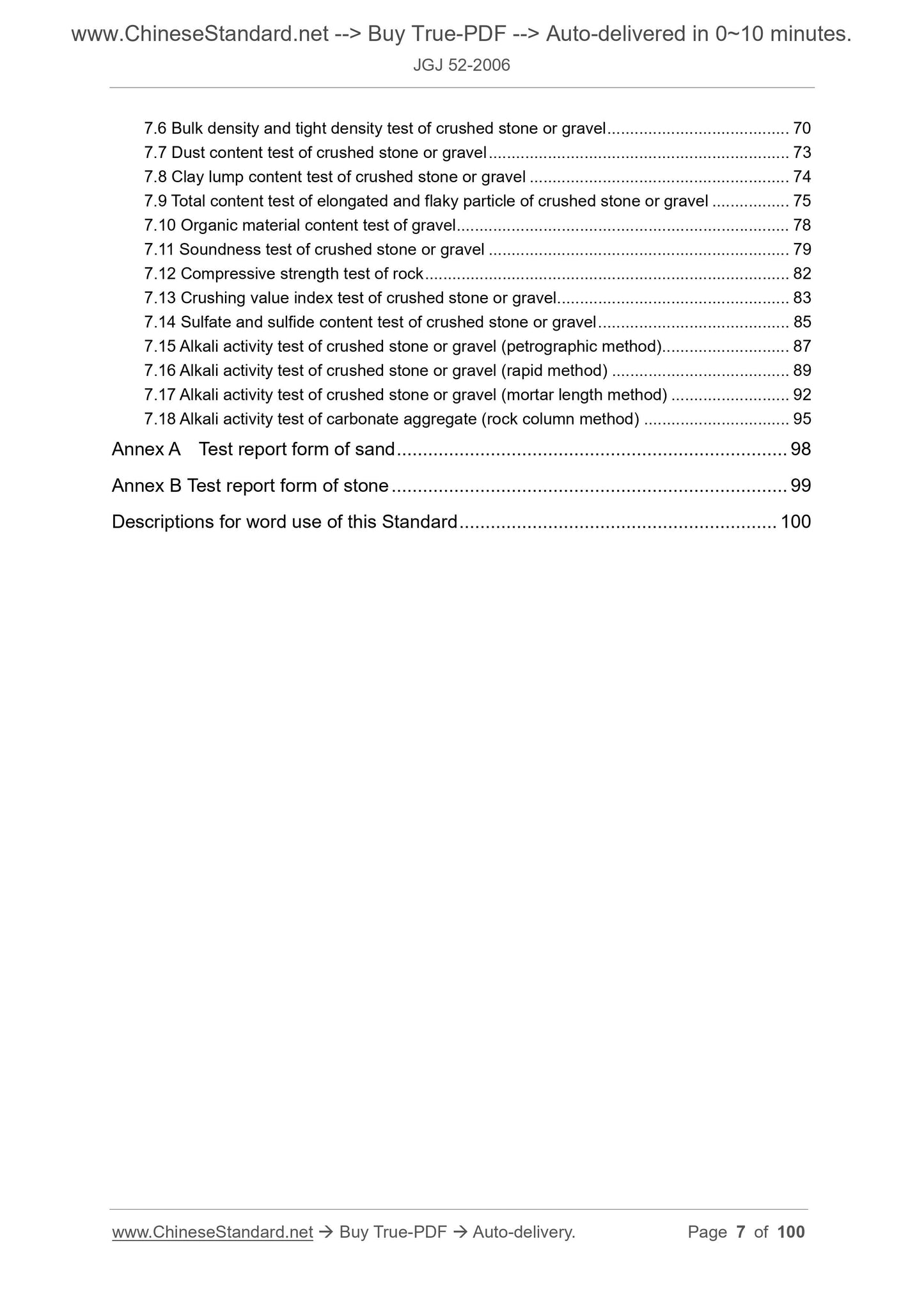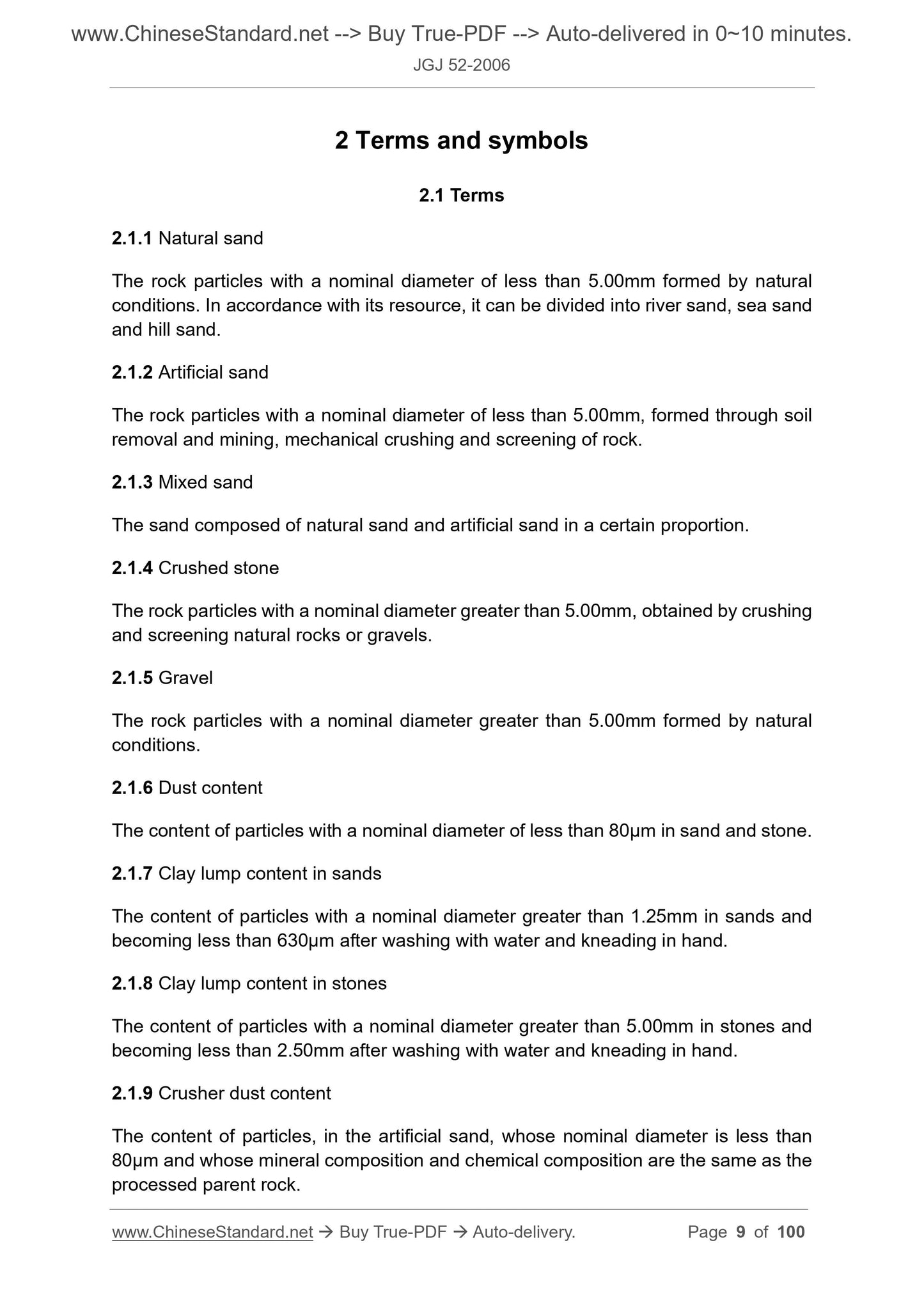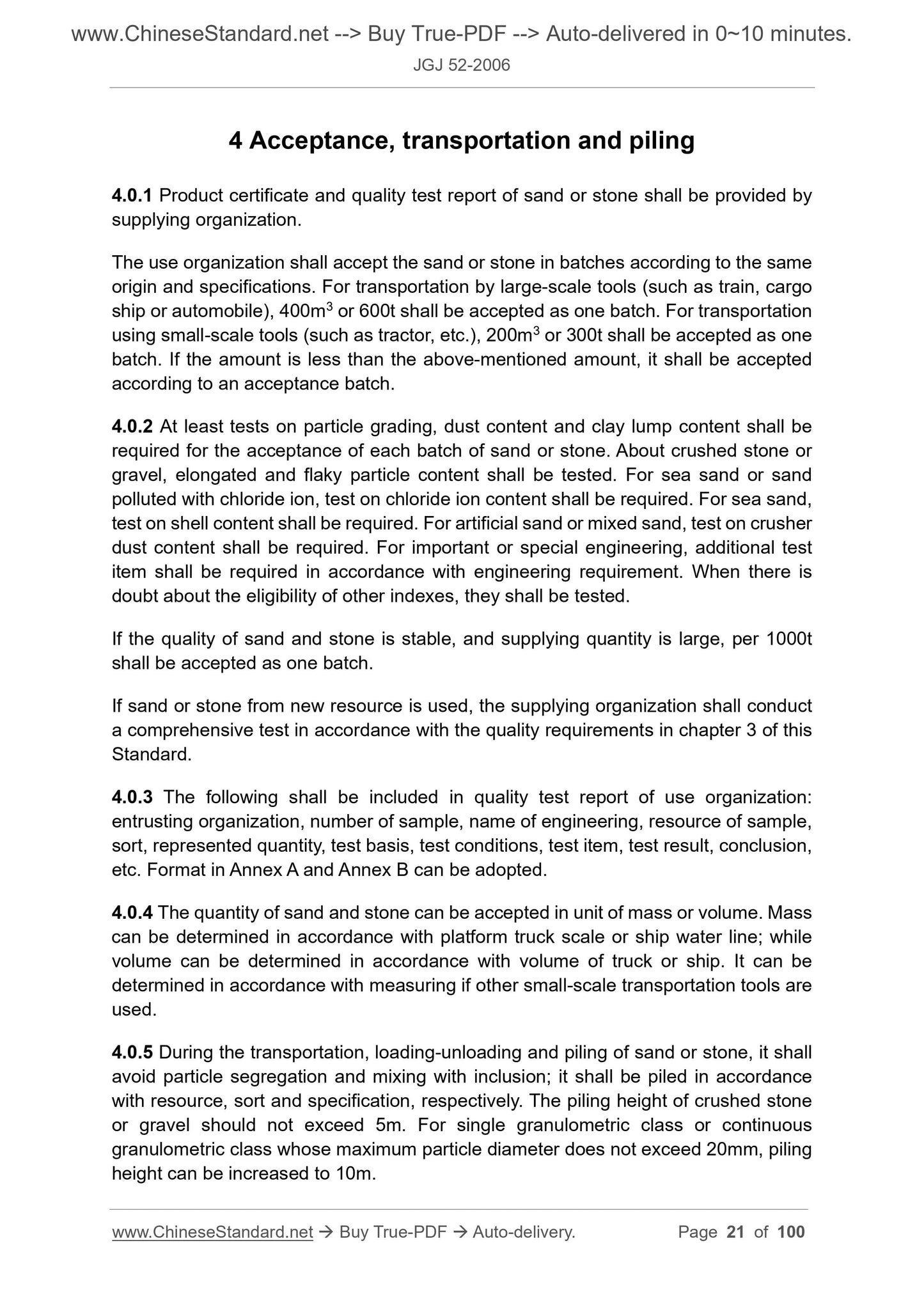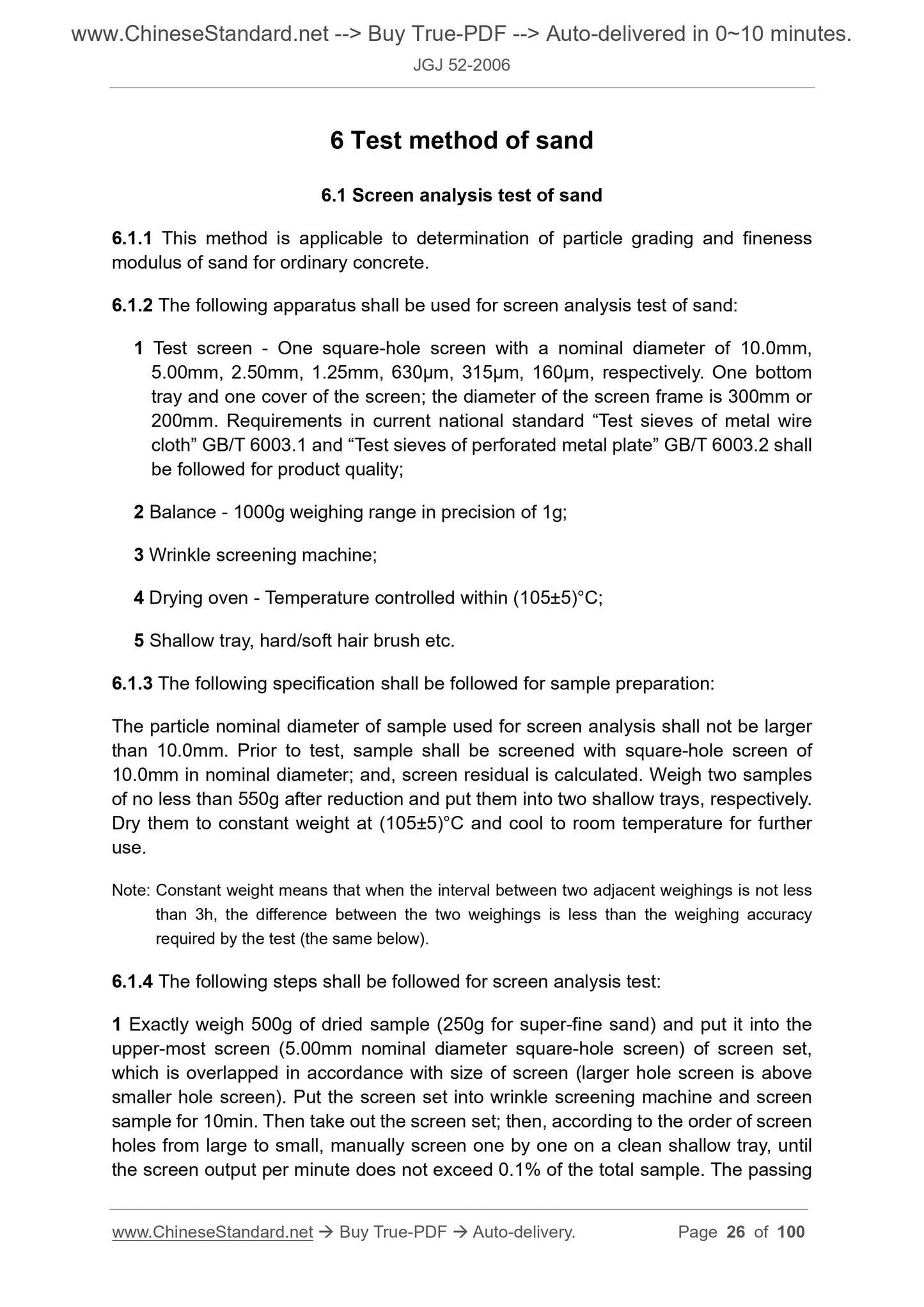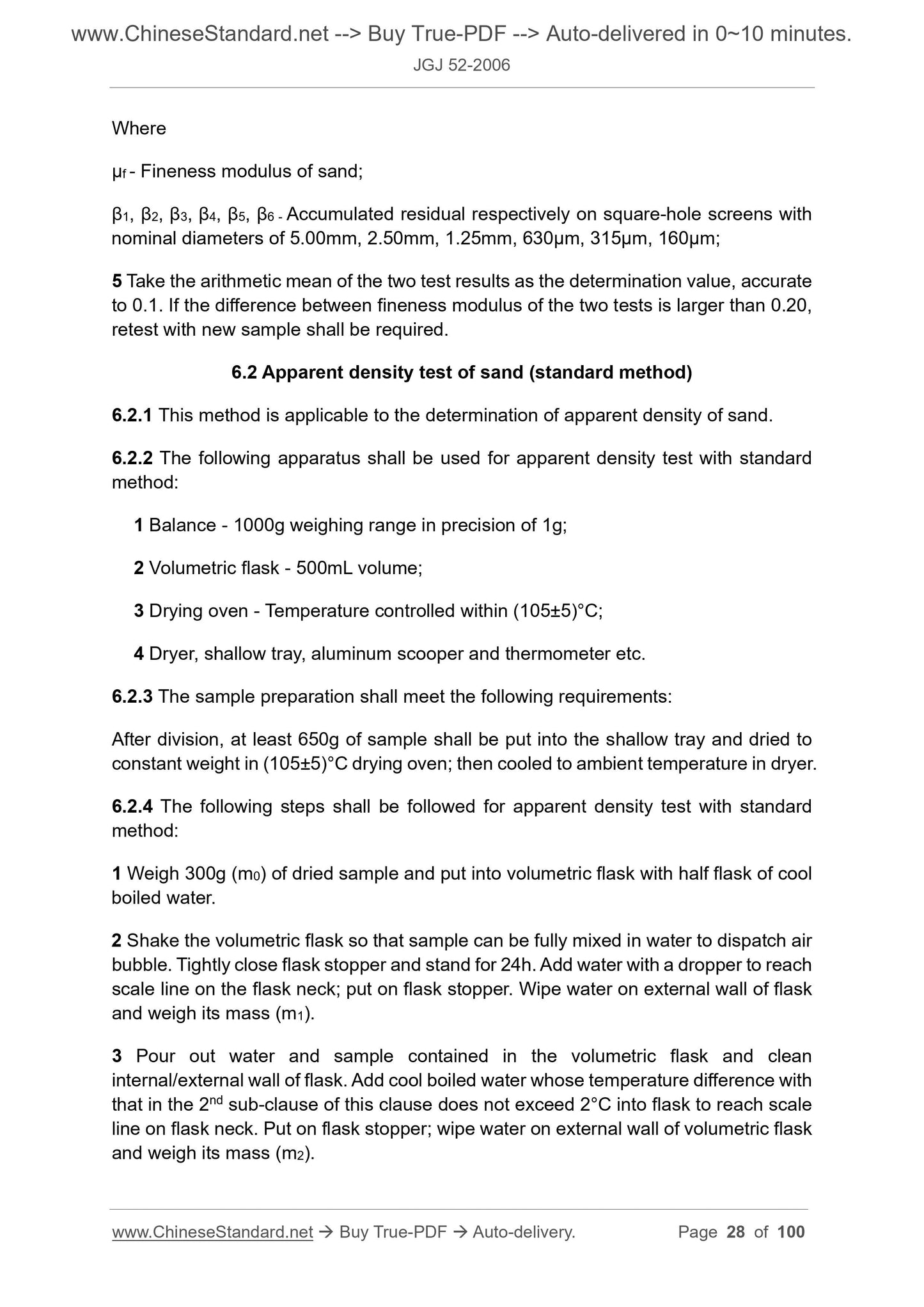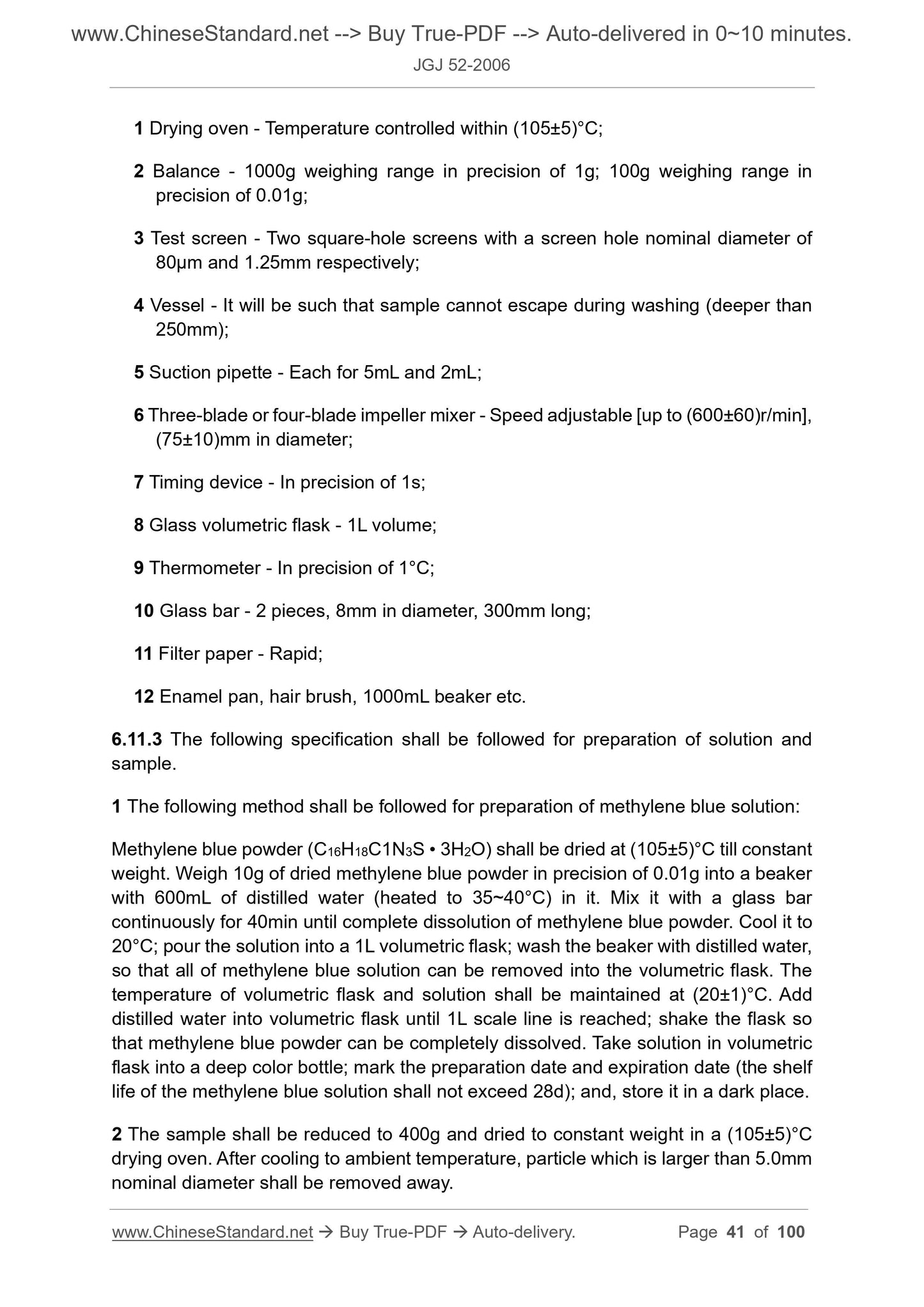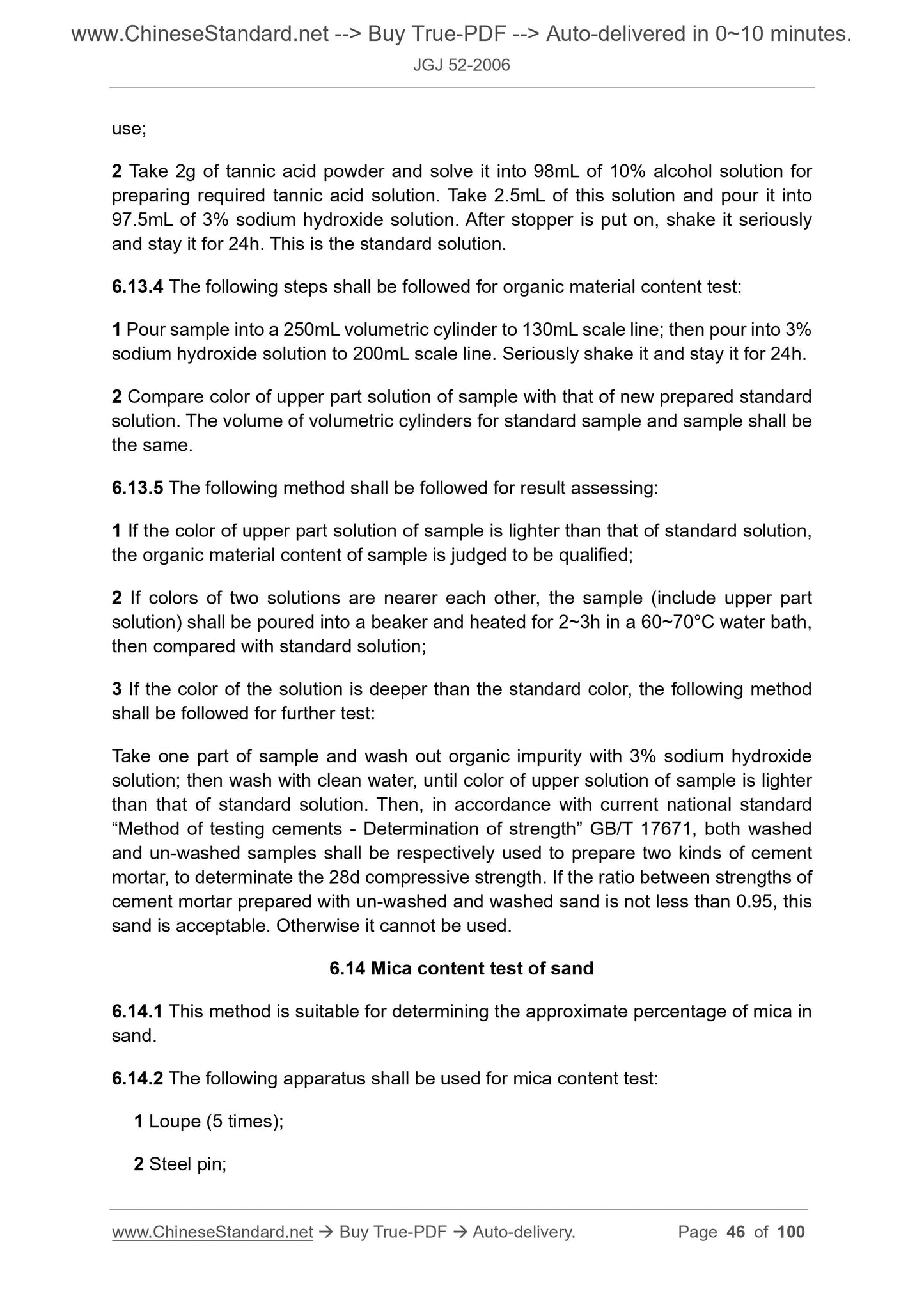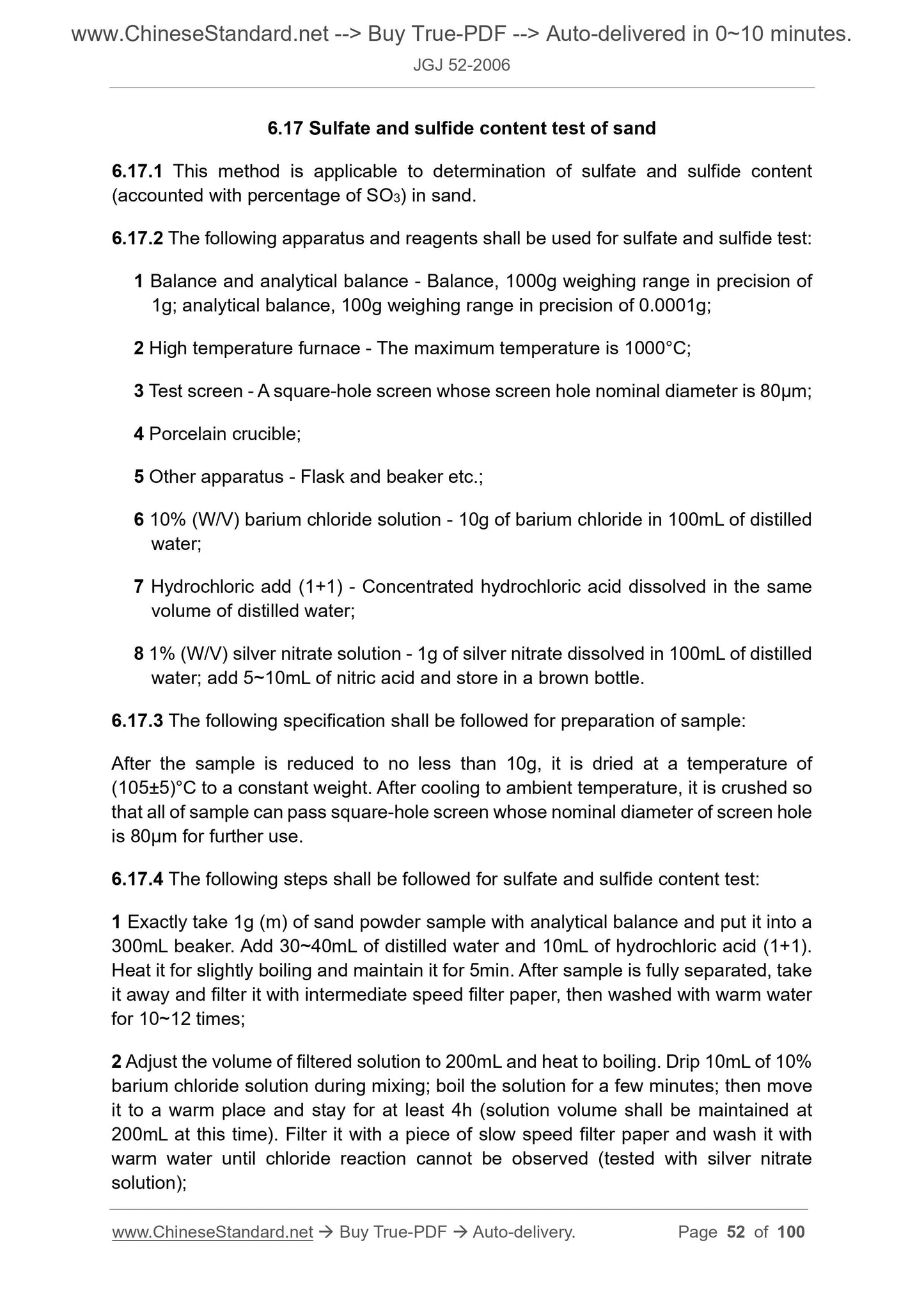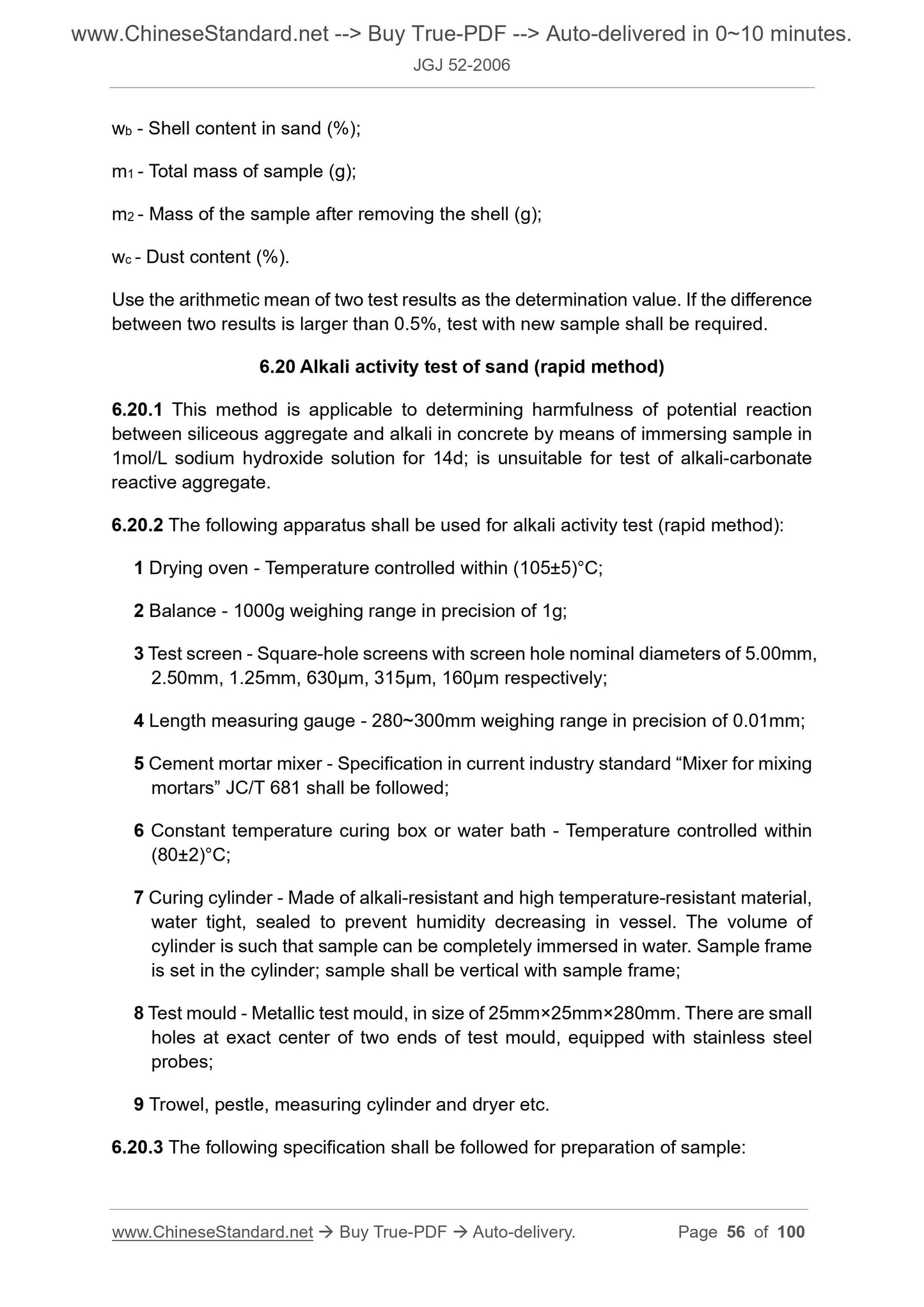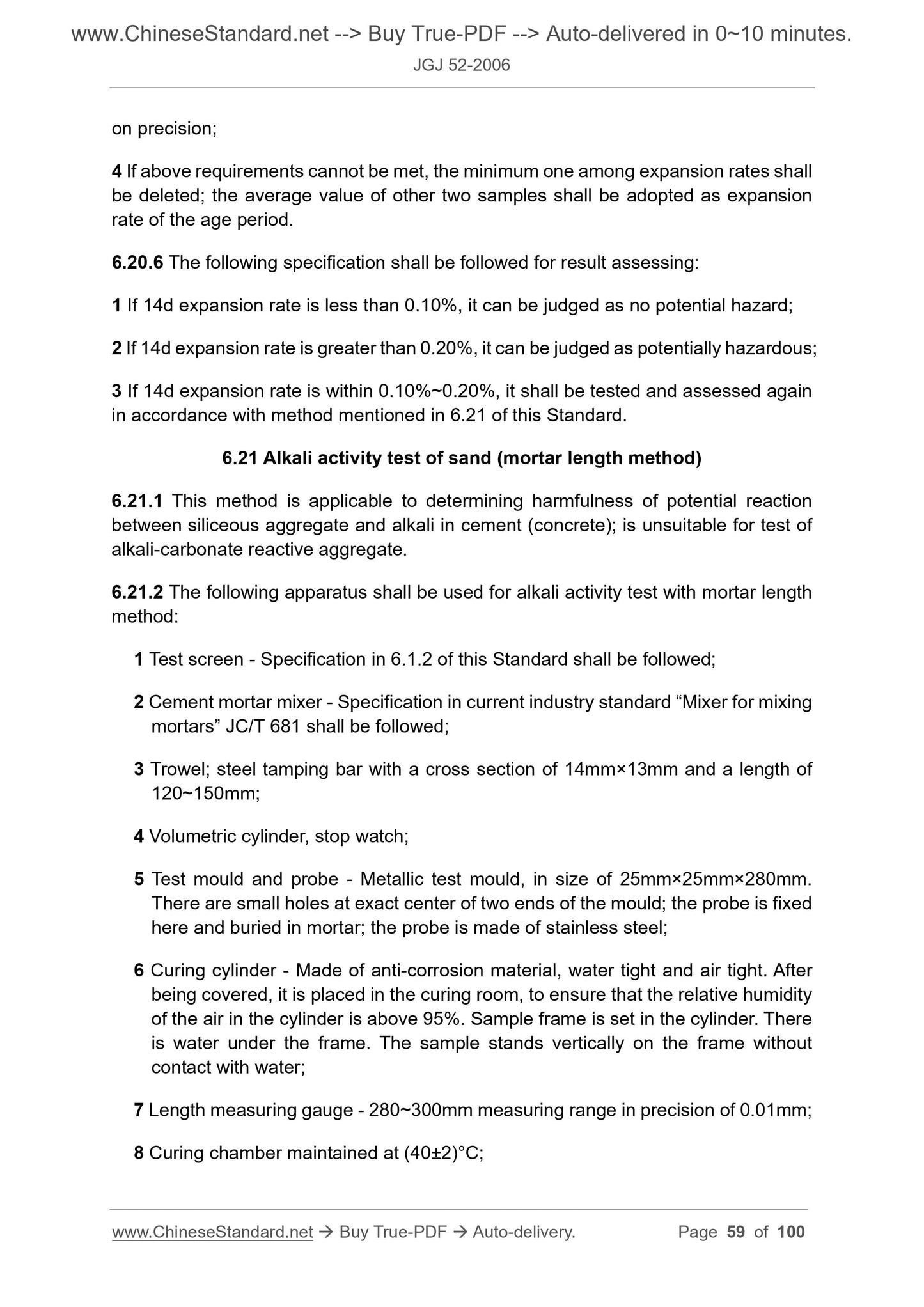1
/
of
12
PayPal, credit cards. Download editable-PDF and invoice in 1 second!
JGJ 52-2006 English PDF
JGJ 52-2006 English PDF
Regular price
$555.00 USD
Regular price
Sale price
$555.00 USD
Unit price
/
per
Shipping calculated at checkout.
Couldn't load pickup availability
Delivery: 3 seconds. Download true-PDF + Invoice.
Get QUOTATION in 1-minute: Click JGJ 52-2006
Historical versions: JGJ 52-2006
Preview True-PDF (Reload/Scroll if blank)
JGJ 52-2006: Standard for technical requirements and test method of sand and crushed stone (or gravel) for ordinary concrete
JGJ 52-2006
UDC JGJ
INDUSTRY STANDARD OF THE
PEOPLE’S REPUBLIC OF CHINA
P JGJ 52-2006
Standard for technical requirements and test method of
sand and crushed stone (or gravel) for ordinary concrete
ISSUED ON: DECEMBER 19, 2006
IMPLEMENTED ON: JUNE 01, 2007
Issued by: Ministry of Construction of the People’s Republic of China
Table of Content
1 General ... 8
2 Terms and symbols ... 9
2.1 Terms ... 9
2.2 Symbols ... 10
3 Quality requirements ... 12
3.1 Quality requirements on sand ... 12
3.2 Quality requirements on stone ... 15
4 Acceptance, transportation and piling ... 21
5 Sampling and division ... 22
5.1 Sampling ... 22
5.2 Division of sample ... 24
6 Test method of sand ... 26
6.1 Screen analysis test of sand ... 26
6.2 Apparent density test of sand (standard method) ... 28
6.3 Apparent density test of sand (simple method) ... 29
6.4 Water-absorbing capacity test of sand ... 31
6.5 Bulk density and tight density test of sand ... 33
6.6 Water content rate test of sand (standard method) ... 35
6.7 Water content rate test of sand (rapid method) ... 36
6.8 Dust content test of sand (standard method) ... 37
6.9 Dust content test of sand (siphon method) ... 38
6.10 Clay lump content test of sand ... 39
6.11 Crusher dust content test of artificial sand and mixed sand (methylene blue method) . 40
6.12 Crushing value index test of artificial sand ... 43
6.13 Organic material content test of sand ... 45
6.14 Mica content test of sand ... 46
6.15 Light material content test of sand ... 47
6.16 Soundness test of sand ... 49
6.17 Sulfate and sulfide content test of sand ... 52
6.18 Chloride ion content test of sand ... 53
6.19 Shell content test of sea sand (hydrochloric acid washing method) ... 54
6.20 Alkali activity test of sand (rapid method) ... 56
6.21 Alkali activity test of sand (mortar length method) ... 59
7 Test method of stone ... 63
7.1 Screen analysis test of crushed stone or gravel ... 63
7.2 Apparent density test of crushed stone or gravel (standard method) ... 64
7.3 Apparent density test of crushed stone or gravel (simple method) ... 66
7.4 Water content rate test of crushed stone or gravel ... 68
7.5 Water-absorbing capacity test of crashed stone or gravel ... 69
7.6 Bulk density and tight density test of crushed stone or gravel ... 70
7.7 Dust content test of crushed stone or gravel ... 73
7.8 Clay lump content test of crushed stone or gravel ... 74
7.9 Total content test of elongated and flaky particle of crushed stone or gravel ... 75
7.10 Organic material content test of gravel ... 78
7.11 Soundness test of crushed stone or gravel ... 79
7.12 Compressive strength test of rock ... 82
7.13 Crushing value index test of crushed stone or gravel ... 83
7.14 Sulfate and sulfide content test of crushed stone or gravel ... 85
7.15 Alkali activity test of crushed stone or gravel (petrographic method) ... 87
7.16 Alkali activity test of crushed stone or gravel (rapid method) ... 89
7.17 Alkali activity test of crushed stone or gravel (mortar length method) ... 92
7.18 Alkali activity test of carbonate aggregate (rock column method) ... 95
Annex A Test report form of sand ... 98
Annex B Test report form of stone ... 99
Descriptions for word use of this Standard ... 100
2 Terms and symbols
2.1 Terms
2.1.1 Natural sand
The rock particles with a nominal diameter of less than 5.00mm formed by natural
conditions. In accordance with its resource, it can be divided into river sand, sea sand
and hill sand.
2.1.2 Artificial sand
The rock particles with a nominal diameter of less than 5.00mm, formed through soil
removal and mining, mechanical crushing and screening of rock.
2.1.3 Mixed sand
The sand composed of natural sand and artificial sand in a certain proportion.
2.1.4 Crushed stone
The rock particles with a nominal diameter greater than 5.00mm, obtained by crushing
and screening natural rocks or gravels.
2.1.5 Gravel
The rock particles with a nominal diameter greater than 5.00mm formed by natural
conditions.
2.1.6 Dust content
The content of particles with a nominal diameter of less than 80μm in sand and stone.
2.1.7 Clay lump content in sands
The content of particles with a nominal diameter greater than 1.25mm in sands and
becoming less than 630μm after washing with water and kneading in hand.
2.1.8 Clay lump content in stones
The content of particles with a nominal diameter greater than 5.00mm in stones and
becoming less than 2.50mm after washing with water and kneading in hand.
2.1.9 Crusher dust content
The content of particles, in the artificial sand, whose nominal diameter is less than
80μm and whose mineral composition and chemical composition are the same as the
processed parent rock.
4 Acceptance, transportation and piling
4.0.1 Product certificate and quality test report of sand or stone shall be provided by
supplying organization.
The use organization shall accept the sand or stone in batches according to the same
origin and specifications. For transportation by large-scale tools (such as train, cargo
ship or automobile), 400m3 or 600t shall be accepted as one batch. For transportation
using small-scale tools (such as tractor, etc.), 200m3 or 300t shall be accepted as one
batch. If the amount is less than the above-mentioned amount, it shall be accepted
according to an acceptance batch.
4.0.2 At least tests on particle grading, dust content and clay lump content shall be
required for the acceptance of each batch of sand or stone. About crushed stone or
gravel, elongated and flaky particle content shall be tested. For sea sand or sand
polluted with chloride ion, test on chloride ion content shall be required. For sea sand,
test on shell content shall be required. For artificial sand or mixed sand, test on crusher
dust content shall be required. For important or special engineering, additional test
item shall be required in accordance with engineering requirement. When there is
doubt about the eligibility of other indexes, they shall be tested.
If the quality of sand and stone is stable, and supplying quantity is large, per 1000t
shall be accepted as one batch.
If sand or stone from new resource is used, the supplying organization shall conduct
a comprehensive test in accordance with the quality requirements in chapter 3 of this
Standard.
4.0.3 The following shall be included in quality test report of use organization:
entrusting organization, number of sample, name of engineering, resource of sample,
sort, represented quantity, test basis, test conditions, test item, test result, conclusion,
etc. Format in Annex A and Annex B can be adopted.
4.0.4 The quantity of sand and stone can be accepted in unit of mass or volume. Mass
can be determined in accordance with platform truck scale or ship water line; while
volume can be determined in accordance with volume of truck or ship. It can be
determined in accordance with measuring if other small-scale transportation tools are
used.
4.0.5 During the transportation, loading-unloading and piling of sand or stone, it shall
avoid particle segregation and mixing with inclusion; it shall be piled in accordance
with resource, sort and specification, respectively. The piling height of crushed stone
or gravel should not exceed 5m. For single granulometric class or continuous
granulometric class whose maximum particle...
Get QUOTATION in 1-minute: Click JGJ 52-2006
Historical versions: JGJ 52-2006
Preview True-PDF (Reload/Scroll if blank)
JGJ 52-2006: Standard for technical requirements and test method of sand and crushed stone (or gravel) for ordinary concrete
JGJ 52-2006
UDC JGJ
INDUSTRY STANDARD OF THE
PEOPLE’S REPUBLIC OF CHINA
P JGJ 52-2006
Standard for technical requirements and test method of
sand and crushed stone (or gravel) for ordinary concrete
ISSUED ON: DECEMBER 19, 2006
IMPLEMENTED ON: JUNE 01, 2007
Issued by: Ministry of Construction of the People’s Republic of China
Table of Content
1 General ... 8
2 Terms and symbols ... 9
2.1 Terms ... 9
2.2 Symbols ... 10
3 Quality requirements ... 12
3.1 Quality requirements on sand ... 12
3.2 Quality requirements on stone ... 15
4 Acceptance, transportation and piling ... 21
5 Sampling and division ... 22
5.1 Sampling ... 22
5.2 Division of sample ... 24
6 Test method of sand ... 26
6.1 Screen analysis test of sand ... 26
6.2 Apparent density test of sand (standard method) ... 28
6.3 Apparent density test of sand (simple method) ... 29
6.4 Water-absorbing capacity test of sand ... 31
6.5 Bulk density and tight density test of sand ... 33
6.6 Water content rate test of sand (standard method) ... 35
6.7 Water content rate test of sand (rapid method) ... 36
6.8 Dust content test of sand (standard method) ... 37
6.9 Dust content test of sand (siphon method) ... 38
6.10 Clay lump content test of sand ... 39
6.11 Crusher dust content test of artificial sand and mixed sand (methylene blue method) . 40
6.12 Crushing value index test of artificial sand ... 43
6.13 Organic material content test of sand ... 45
6.14 Mica content test of sand ... 46
6.15 Light material content test of sand ... 47
6.16 Soundness test of sand ... 49
6.17 Sulfate and sulfide content test of sand ... 52
6.18 Chloride ion content test of sand ... 53
6.19 Shell content test of sea sand (hydrochloric acid washing method) ... 54
6.20 Alkali activity test of sand (rapid method) ... 56
6.21 Alkali activity test of sand (mortar length method) ... 59
7 Test method of stone ... 63
7.1 Screen analysis test of crushed stone or gravel ... 63
7.2 Apparent density test of crushed stone or gravel (standard method) ... 64
7.3 Apparent density test of crushed stone or gravel (simple method) ... 66
7.4 Water content rate test of crushed stone or gravel ... 68
7.5 Water-absorbing capacity test of crashed stone or gravel ... 69
7.6 Bulk density and tight density test of crushed stone or gravel ... 70
7.7 Dust content test of crushed stone or gravel ... 73
7.8 Clay lump content test of crushed stone or gravel ... 74
7.9 Total content test of elongated and flaky particle of crushed stone or gravel ... 75
7.10 Organic material content test of gravel ... 78
7.11 Soundness test of crushed stone or gravel ... 79
7.12 Compressive strength test of rock ... 82
7.13 Crushing value index test of crushed stone or gravel ... 83
7.14 Sulfate and sulfide content test of crushed stone or gravel ... 85
7.15 Alkali activity test of crushed stone or gravel (petrographic method) ... 87
7.16 Alkali activity test of crushed stone or gravel (rapid method) ... 89
7.17 Alkali activity test of crushed stone or gravel (mortar length method) ... 92
7.18 Alkali activity test of carbonate aggregate (rock column method) ... 95
Annex A Test report form of sand ... 98
Annex B Test report form of stone ... 99
Descriptions for word use of this Standard ... 100
2 Terms and symbols
2.1 Terms
2.1.1 Natural sand
The rock particles with a nominal diameter of less than 5.00mm formed by natural
conditions. In accordance with its resource, it can be divided into river sand, sea sand
and hill sand.
2.1.2 Artificial sand
The rock particles with a nominal diameter of less than 5.00mm, formed through soil
removal and mining, mechanical crushing and screening of rock.
2.1.3 Mixed sand
The sand composed of natural sand and artificial sand in a certain proportion.
2.1.4 Crushed stone
The rock particles with a nominal diameter greater than 5.00mm, obtained by crushing
and screening natural rocks or gravels.
2.1.5 Gravel
The rock particles with a nominal diameter greater than 5.00mm formed by natural
conditions.
2.1.6 Dust content
The content of particles with a nominal diameter of less than 80μm in sand and stone.
2.1.7 Clay lump content in sands
The content of particles with a nominal diameter greater than 1.25mm in sands and
becoming less than 630μm after washing with water and kneading in hand.
2.1.8 Clay lump content in stones
The content of particles with a nominal diameter greater than 5.00mm in stones and
becoming less than 2.50mm after washing with water and kneading in hand.
2.1.9 Crusher dust content
The content of particles, in the artificial sand, whose nominal diameter is less than
80μm and whose mineral composition and chemical composition are the same as the
processed parent rock.
4 Acceptance, transportation and piling
4.0.1 Product certificate and quality test report of sand or stone shall be provided by
supplying organization.
The use organization shall accept the sand or stone in batches according to the same
origin and specifications. For transportation by large-scale tools (such as train, cargo
ship or automobile), 400m3 or 600t shall be accepted as one batch. For transportation
using small-scale tools (such as tractor, etc.), 200m3 or 300t shall be accepted as one
batch. If the amount is less than the above-mentioned amount, it shall be accepted
according to an acceptance batch.
4.0.2 At least tests on particle grading, dust content and clay lump content shall be
required for the acceptance of each batch of sand or stone. About crushed stone or
gravel, elongated and flaky particle content shall be tested. For sea sand or sand
polluted with chloride ion, test on chloride ion content shall be required. For sea sand,
test on shell content shall be required. For artificial sand or mixed sand, test on crusher
dust content shall be required. For important or special engineering, additional test
item shall be required in accordance with engineering requirement. When there is
doubt about the eligibility of other indexes, they shall be tested.
If the quality of sand and stone is stable, and supplying quantity is large, per 1000t
shall be accepted as one batch.
If sand or stone from new resource is used, the supplying organization shall conduct
a comprehensive test in accordance with the quality requirements in chapter 3 of this
Standard.
4.0.3 The following shall be included in quality test report of use organization:
entrusting organization, number of sample, name of engineering, resource of sample,
sort, represented quantity, test basis, test conditions, test item, test result, conclusion,
etc. Format in Annex A and Annex B can be adopted.
4.0.4 The quantity of sand and stone can be accepted in unit of mass or volume. Mass
can be determined in accordance with platform truck scale or ship water line; while
volume can be determined in accordance with volume of truck or ship. It can be
determined in accordance with measuring if other small-scale transportation tools are
used.
4.0.5 During the transportation, loading-unloading and piling of sand or stone, it shall
avoid particle segregation and mixing with inclusion; it shall be piled in accordance
with resource, sort and specification, respectively. The piling height of crushed stone
or gravel should not exceed 5m. For single granulometric class or continuous
granulometric class whose maximum particle...
Share
